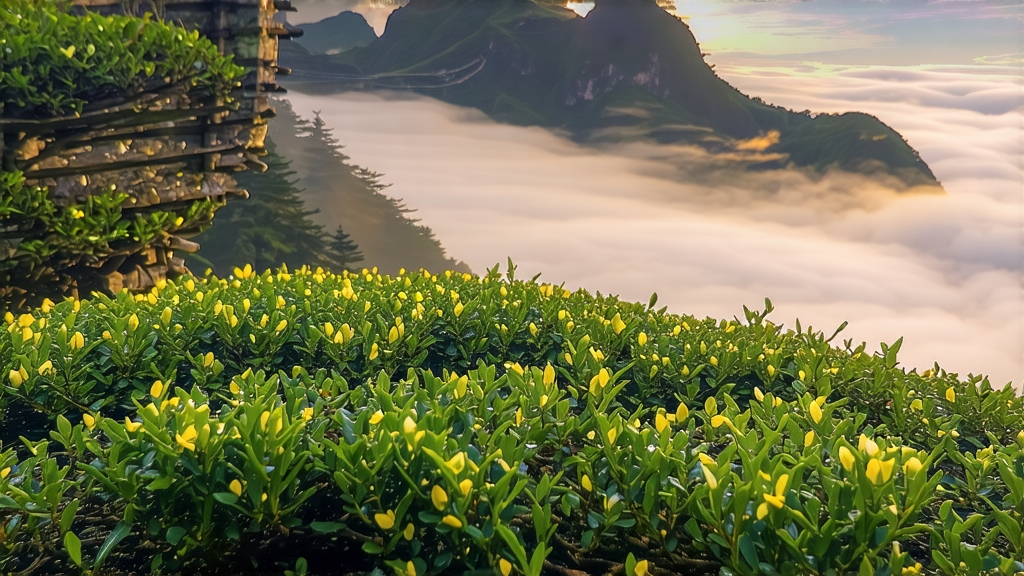
Tucked high on mist-crowned Mengding Mountain in Sichuan Province, Mengding Huangya—literally “Yellow Bud of Mengding”—is the tea that once graced the porcelain cups of Tang-dynasty emperors yet remains a quiet legend outside China. While green tea steals the spotlight for freshness and pu-erh for age-worthiness, yellow tea occupies a slender, fragrant niche where oxidation is paused, then coaxed back to life in a warm, humid cocoon, yielding a liquor the color of late-afternoon sunlight and a flavor that bridges the verdant snap of greens with the mellow depth of lightly aged whites. Mengding Huangya is the oldest recorded yellow tea, its first tribute entry dating to 724 CE, when monks from the Ganlu Temple presented it to Emperor Xuanzong; for the next eleven centuries it remained an imperial tax, freighted down the Min River and onward to Chang’an in bamboo-lined chests sealed with camphor leaves.
The mountain itself is a natural tea laboratory. Rising 1 456 m above the Chengdu Plain, Mengding catches the tail of the Sichuan basin’s monsoon, so clouds collide with cool alpine air, creating a 280-day fog season. The diffused light slows photosynthesis, stockpiling amino acids—especially L-theanine—in the diminutive buds. Local lore claims that the “five covering peaks” circling the plantation act like the petals of a lotus, cradling the tea garden in a microclimate where average humidity hovers at 86 %. The cultivar of choice is the indigenous Mengding #9, a slow-budding shrub whose leaves remain hairy and lime-green even at full maturity, ideal for the delicate “one bud, one leaf” pluck standard demanded for top-grade Huangya.
Harvest is a race against the Qingming festival: only fifteen days in late March qualify. At dawn, pickers—often sixth-generation tea farmers—climb stone steps slick with moss, shears tucked into bamboo baskets lined with wet cotton. The rule is “three no-picks”: no buds longer than 2.5 cm, no leaves damaged by leafhoppers, no stems tinged with purple. By 9 a.m. the baskets descend to the monastery courtyard where the 2 000-year-old “Twelve Steps of Ganlu” ritual begins.
Step one is indoor withering. The buds are spread on hemp mats in a drafty hall heated only by mountain spring water pipes; temperature is held at 28 °C for 90 minutes to reduce grassy volatiles. Next comes the kill-green, but here the similarity to green tea ends. A 1.2 m diameter iron wok is heated with burning cedar; when its surface reaches 140 °C the buds are tossed by hand for exactly 45 seconds—long enough to denature polyphenol oxidase at the leaf edge yet leave the core enzymes alive. The leaves are then wrapped, still hot, in thick cotton cloths and placed inside a pine box lined with wet paper. This is the “sealed yellowing” (men huang), the soul of yellow tea. Over three successive nights the bundles are opened, re-heated, and re-wrapped; each cycle lasts eight hours, during which chlorophyll gently breaks down into pheophytin, catechins dimerize into theaflavins, and a whisper of Maillard browning paints the buds antique gold. By the third morning the leaves smell of fresh chestnut and steamed japonica rice; their surface is matte, no longer the glossy emerald of a green tea.
The final low-temperature bake employs charcoal made from local walnut wood; the fire is smothered with ash so that heat kisses rather than sears. A master will “listen” to the crackle of residual moisture, adjusting the depth of ash every ten minutes. When the moisture drops to 5 % the leaves are left to breathe for 24 hours, then graded by sight and sound: top-grade Huangya should “stand” when dropped onto a porcelain plate, the bud snapping upright like a miniature sword.
To brew Mengding Huangya abroad, use soft water low in bicarbonates; 80 °C is the inflection point where sweetness outruns astringency. A tall, thin-walled glass gaiwan (120 ml) showcases the ballet of buds sinking vertically—an old poet’s metaphor for “needles of mist threading the valley.” Use 3 g of leaf, a 15